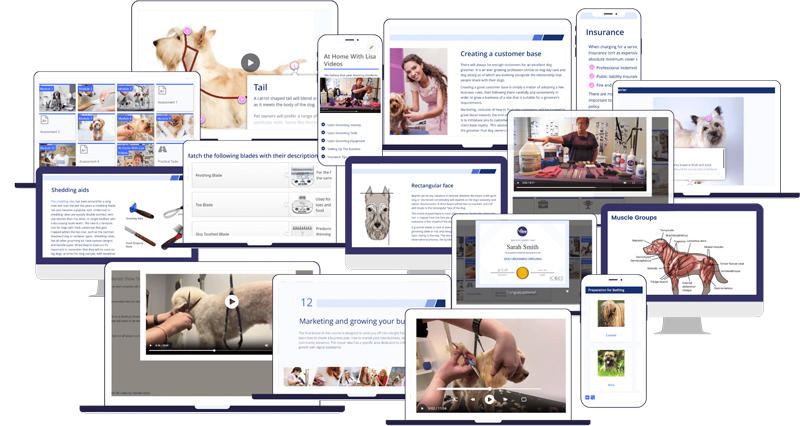Whether you're a pet enthusiast or planning to work with animals professionally, it is crucial to learn pet first aid skills.
The safety of the animals under your care should always be your top priority, and knowing how to administer life-saving first aid can also give your clients confidence in your services. This Dog Grooming First Aid Certificate will equip you with the necessary skills and knowledge to respond confidently and calmly in a pet emergency, providing the best possible chance of a full recovery.
Starting with learning about the essential items you need in your first aid kit, this course will teach you how to check an animal's health by taking its temperature, pulse, and examining its skin and eyes. You'll also learn vital procedures such as dog CPR, cleaning and bandaging, and scenario-based learning that will prepare you for emergencies such as road traffic accidents, snake bites, and seizures. You'll be surprised by how much there is to learn about pet first aid and how important this knowledge will be in your professional canine career.
A great course for those that want to work with dogs in any capacity and who wants to be confident in a pet emergency.
What Sets Us Apart?
A distinctive feature of our course lies in the outcomes of our students. We take great pride in sharing the stories of individuals who have not only completed our course but have also established their own thriving dog grooming businesses. We are proud of these success stories as they serve as a testament to the effectiveness of our course, as do our reviews on Trust Pilot.

Very interesting to research the subjects, I found the course informative and enjoyable.
Why Choose Vibe
- Proven Track Record
- 100% Online Learning Experience
- Expert Mentors to Guide You
- Business Training You Can Use
- No Additional or Hidden Fees

Course Modules
- First aid and the law
- The importance of your role
- Keeping animals safe in an emergency
- Precautions and safety
- Accident prevention
- First Aid Kits
- Bandaging materials
- Scrubs, wipes and powders
- Ticks, tweezers and lubrications
- Elizabeth collar
- Initial assessment
- Hands on assessment
- Taking a pulse
- Checking gums
- Dehydration and teeth
- Checking Eyes
- Checking Skin
- Checking temperature
- Checking For pain
- Triage and Vital Signs
- Vomitting and diarrhoea
- Hyperthermia and Hypothermia
- Coughing and Breathing
- Ears and Eyes
- Mouths
- Scooting Bottom
- Scratching and Chewing
- Limping and lethargy
- Procedures
- Restraint
- CPR
- Bleeding
- Cleaning and Bandaging
- Tails and Ears
- Eyes
- Anal Glands
- Choking
- Road Traffic Accidents
- Shock
- Fractures and Wounds
- Town Nails
- Burn and Spinal Injuries
- Blockages, Bloat and Bites
- Accidental Poisoning
- Snake Bites
- Eye and Ear Foreign Bodies
- Seizures
Course Mentor

"I'm always here to help and am very easy to approach."
Meet Hannah Grice, the passionate owner and head groomer behind The Dog House, a charming boutique dog grooming establishment. With a wealth of experience and accolades under her belt, Hannah's journey into the world of grooming began with her beloved Poodles, Ivy and Raven, who not only stole her heart but also propelled her to success in grooming and obedience competitions.
Certified and mentored by renowned groomers like Tiarne Perkiss and Christine Speerin, Hannah brings a unique blend of expertise and enthusiasm to her teaching endeavors. Whether guiding students through our online courses or presenting grooming video tutorials, she ensures a supportive and constructive learning environment every step of the way.
Frequently Asked Questions
We provide lifetime access! This course is designed for self-paced learning, which means you have the freedom to study on your own schedule.
There are no time limits or deadlines, and you have 24/7 access to the course. You'll have all the flexibility and convenience to balance your studies with other commitments.
You can take as much time as needed to complete this course as there are no deadlines or timeframes. As a guideline the course has a duration of 100 study hours, with most students completing within 3 months.
There are multiple choice quizzes that you will complete at the end of each module. You can complete them as many times as you need to.
These assessments will help you understand the material and will reinforce your learning. There are no deadlines on any of the assessments.
Want To Learn More?
GET MORE INFOPayment Options

Hassle Free 7-Day Money Back Guarantee
We stand by the quality of our online courses, and to ensure your satisfaction, we offer a hassle-free 7-day money-back guarantee. This means you'll have an entire week to explore all the course materials. If, within that time frame, you find that the course doesn't align with your expectations or learning goals, simply shoot us an email, and we'll process a full refund for you.
We believe in the value our course provides, but we also understand that it might not be the perfect fit for everyone. Your satisfaction is our priority, and we want you to feel confident in your investment with us.
Ready to get started?
Enrol NowOur Values
Learn At Your Own Pace
We believe in personalised learning. That's why we provide all the tools and support you need to succeed at your own pace. With flexible learning, you'll stay motivated and retain more information. Plus, you can balance your studies with work and family commitments to make your dreams a reality.
We Won't Break The Bank
Education should be accessible to anyone who wants to learn. That's why we offer some of the most competitive prices in the industry with payments plans for just $25 per week. Investing in your future is a smart choice and doesn’t have to break the bank.
Industry-Led Courses
There's no better way to learn than from experts with years of experience in your field. That's why each of our 200+ industry-led courses are designed to give you a real-life perspective on your industry. With our expert mentors, you'll learn from people who have a wealth of knowledge and experience, and who are passionate about sharing it with you.
Get The Personal Support You Deserve
At Vibe Learning, we're real people who are dedicated to providing you with personal support every step of the way. Our industry experts are not only professional and knowledgeable but also incredibly passionate about sharing their expertise with you. With their guidance, you'll gain invaluable insights and practical knowledge to help you succeed.
Still looking?
Check out the following courses related to Dog Grooming First Aid:
























































